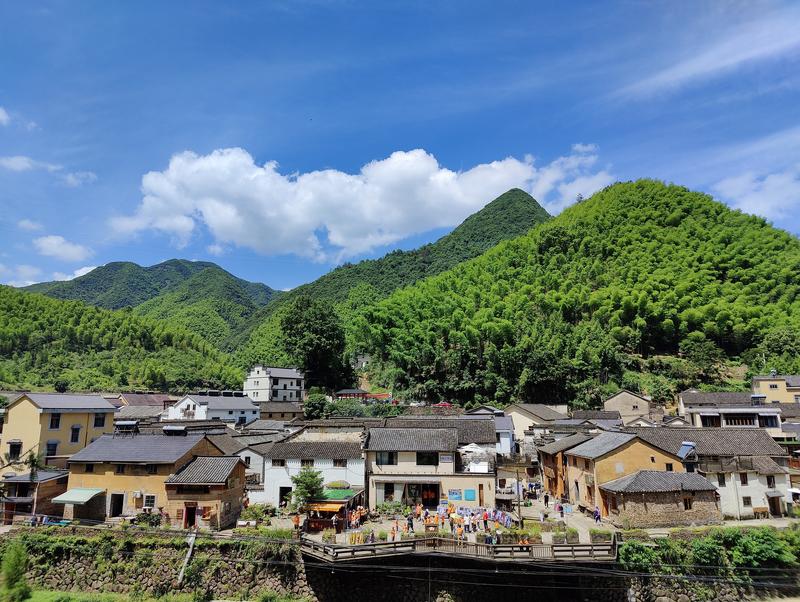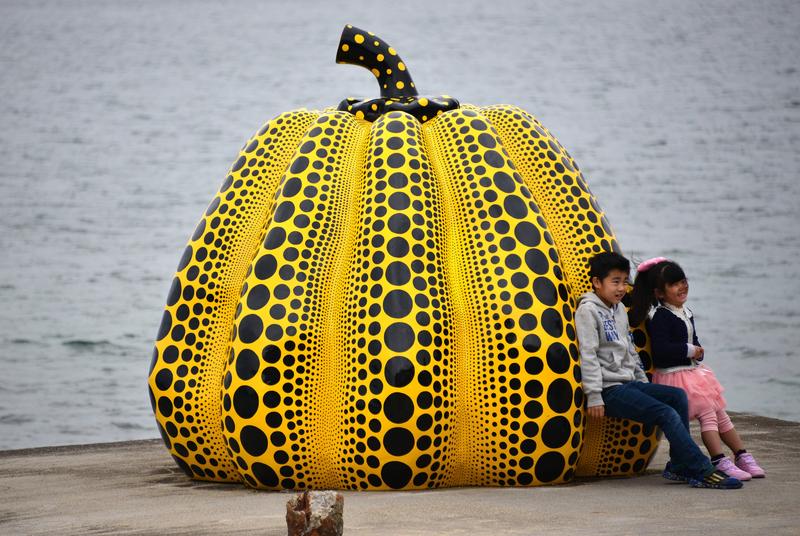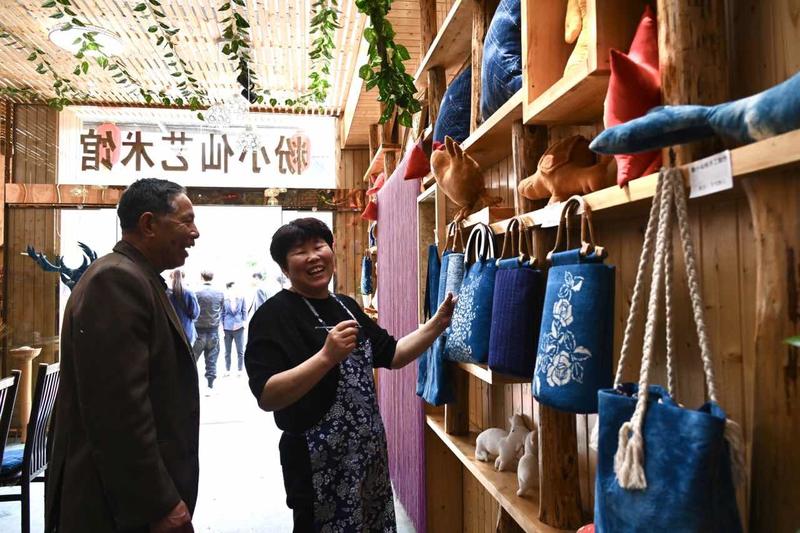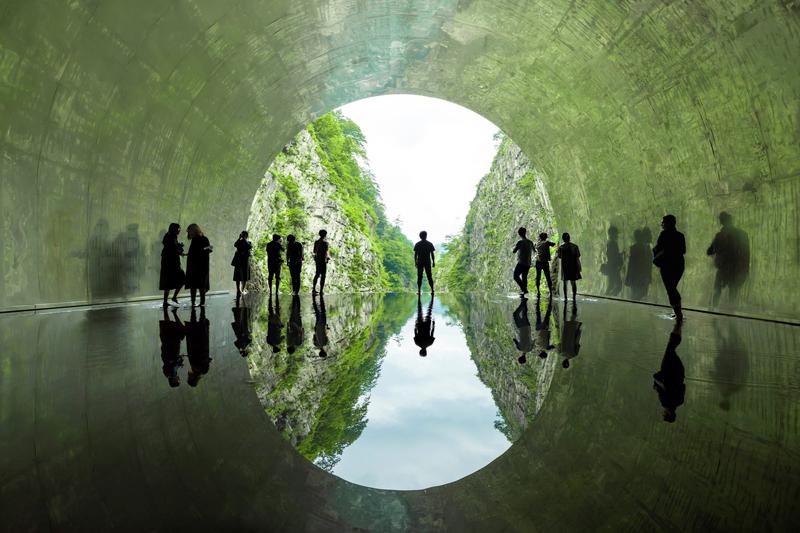Creative approach taken to vitalize the countryside
 The village of Shishe in Tonglu county, Zhejiang province, is rising in popularity among tourists because of its burgeoning reputation of art. (PHOTO PROVIDED TO CHINA DAILY)
The village of Shishe in Tonglu county, Zhejiang province, is rising in popularity among tourists because of its burgeoning reputation of art. (PHOTO PROVIDED TO CHINA DAILY)
Xing Weibin likes nothing more than to have breakfast in nature. A cup of coffee and a good book in the early morning sunshine at his Saxiu art space is Xing's idea of bliss.
Rural China is attracting an increasing number of urbanites like Xing, luring them away from the hustle and bustle of the city for the quiet life in the countryside.
Xing, a lifelong lover of the countryside, visited the village of Shishe in Tonglu county, Zhejiang in 2015. The 56-square-kilometer village has around 900 residents and sits among a serene natural environment.
"It is quiet but not deserted, it is not overdeveloped and the architecture and population size is perfect to create that idyllic model village people picture in their minds," said Xing.
To chase his dream lifestyle in rural China, Xing decided to create an art space and chose Shishe as the ideal location.
"I wanted to create an art space here with cultural characteristics. Artists can share their ideas in the space and residents and visitors can enjoy the art," Xing said.
"I hope the space can spread the spirit of the rural lifestyle to the people who come and become an incubator for more such places in the future."
 Xing Weibin (middle) chats with his friends at his Saxiu art space in the village of Shishe. (PHOTO PROVIDED TO CHINA DAILY)
Xing Weibin (middle) chats with his friends at his Saxiu art space in the village of Shishe. (PHOTO PROVIDED TO CHINA DAILY)
Xing thinks the village of Shishe can be an entire economic ecosystem in itself with art at the center of increasing the village's economic output.
In his plans, people from different walks of life not commonly seen in rural China, such as artists, would come to the space to work or exhibit and the villagers and visitors can also participate in the activities.
Xing started his project in 2016 shortly after his first visit, acquiring the relevant permissions and renting some local residences to transform into his art space.
Now identifying himself as a curator and a practitioner of rural vitalization, Xing invested 2 million yuan ($310,000) in the renovation project, and invited his friends-artists, scholars and entrepreneurs-to Saxiu art space for its opening ceremony a year later in 2017.
"Apart from holding exhibitions and lectures, the space also functions as a rural library, operating in connection with the provincial library in Hangzhou," Xing said.
"It is also my intention to hold book readings here and provide a cozy reading environment."
 Houses in the village of Gejia, Ninghai, have been refurbished and redecorated. (PHOTO PROVIDED TO CHINA DAILY)
Houses in the village of Gejia, Ninghai, have been refurbished and redecorated. (PHOTO PROVIDED TO CHINA DAILY)
Saxiu has held a variety of events since its opening, from art exhibitions and book-sharing events to coffee-tastings, attracting tourists, artists and even government officials to enjoy the rural art experience.
"The opening of the space has even aroused the villagers' love and passion for their own home," Xing said.
"I believe rural vitalization through art cannot depend on artists alone, because they are confined to their own creations. The core is to stick to local craftsmanship, tradition and culture."
A similar pattern of rural vitalization through art has been seen in other parts of the world as well.
In Japan, village vitalization campaigns, usually sponsored by the prefectural or municipal government, have been seen since the 1970s. Renowned campaigns include the "one village, one product" movement to stimulate local economic development.
Art became part of the campaign in the 2000s. Under government sponsorship and efforts from individual artists, art festivals became an iconic activity in rural Japan to attract tourists.
 The "Yellow Pumpkin" by Yayoi Kusama displayed in Japan's Kagawa prefecture in March 2016, is a part of the Setouchi Triennale. (PHOTO PROVIDED TO CHINA DAILY)
The "Yellow Pumpkin" by Yayoi Kusama displayed in Japan's Kagawa prefecture in March 2016, is a part of the Setouchi Triennale. (PHOTO PROVIDED TO CHINA DAILY)
Fram Kitagawa, one of the initiators and organizers of the Echigo-Tsumari Art Triennale in Niigata prefecture and the Setouchi Triennale at the Seto Inland Sea, two well-known art festivals in rural Japan, thinks art in this context refers to "discovering, learning, communication and cooperation".
The goal of his art campaign is to encourage artists from different places to discover the locale, to learn from and communicate with local people, and achieve cooperation among artists, government and local residents.
"When I meet artists who come to Echigo-Tsumari for the first time, I will spend up to half an hour and familiarize them with the abandoned farmland, increasing number of vacant houses and a stagnated textile industry here, instead of just saying 'the vegetables here taste good'." Kitagawa wrote in his book, Echigo-Tsumari Art Triennale Concept Book.
Successfully held seven times since June 2000, the "Echigo-Tsumari" model, under which art plays the key role in bringing vitality to rural areas caught the attention of neighboring countries and regions in Asia.
 The village of Gejia in Ninghai, Zhejiang province, is decorated with artistic displays. (PHOTO PROVIDED TO CHINA DAILY)
The village of Gejia in Ninghai, Zhejiang province, is decorated with artistic displays. (PHOTO PROVIDED TO CHINA DAILY)
In 2019, Xing reached a preliminary deal to cooperate with the Echigo-Tsumari Art Triennale, inviting artists to the village of Shishe to experience rural China for the first time.
"Things were put aside because of COVID-19, and I still hope more artists can visit Shishe when the epidemic is over," Xing said.
"Saxiu art space is just a beginning, my next plan is to discover more remote and natural places and build more art spaces across China and inspire more people to discover the beauty of rural China."
"Rural vitalization through art is an important way to develop rural areas. Art refers to not only high culture, but also grassroots culture and traditional local culture," said Sun Jiashan, a researcher with the Chinese National Academy of Arts.
"Rural vitalization through art does not have a fixed pattern, it must utilize local resources and inspire local residents," Sun added.
Chen Xiwen, an agricultural expert and official with the National People's Congress believes that rural vitalization in China is an inevitable pathway to achieving xiaokang-a moderately prosperous society, and to building the country into a "great modern socialist country".
 Yuan Xiaoxian (right) arranges cloth bags for sale at her shop in the village of Gejia. (PHOTO PROVIDED TO CHINA DAILY)
Yuan Xiaoxian (right) arranges cloth bags for sale at her shop in the village of Gejia. (PHOTO PROVIDED TO CHINA DAILY)
While the central government has always attached importance to issues related to agriculture, farming and rural areas, the strategy of rural vitalization was first proposed by the Communist Party of China at the 19th CPC National Congress in 2017.
With the nation achieving poverty alleviation in 2020, perhaps the best time has arrived to "art up" rural China.
In Zhejiang province, more artistic villages are flourishing with the efforts of people like Xing and the local government.
Cong Zhiqiang was in search for a place to put into practice his ideas about art.
An associate professor from the School of Arts at Renmin University of China for many years, Cong researched how traditional rural villages can vitalize through art.
Luck found him in 2019 when he met Li Guijun, deputy party secretary of Ninghai county in Zhejiang province.
The two of them soon hit it off when they found a shared goal, to find an effective way to beautify and vitalize villages in one way or another, and this time, through art.
Ninghai county in Zhejiang province has a population of 690,000. The GDP of the county in 2020 was 72.2 billion yuan. In 2019, the county government started its "rural vitalization through art" project, collaborating with local residents and higher education institutions, inviting artists to come to villages and give their opinions and ideas.
In April 2019, Cong and a group of his students visited Gejia, a village with a 1,200-year history, with the majority of residents making a living from weaving bamboo.
At first, the local residents didn't really understand the aims of the project.
 The Kiyotsu Gorge Tunnel is restored as an artistic space for the Echigo-Tsumari Art Triennale in Niigata prefecture, Japan, in July 2018. (PHOTO PROVIDED TO CHINA DAILY)
The Kiyotsu Gorge Tunnel is restored as an artistic space for the Echigo-Tsumari Art Triennale in Niigata prefecture, Japan, in July 2018. (PHOTO PROVIDED TO CHINA DAILY)
A lecture was given by Cong the next day better explaining to villagers how he was going to vitalize the village with art.
The villagers remained unconvinced, but Cong did not give up and began observing the village. He made a bench and placed it in front of the villagers' cultural activity center, so people would be reminded of the project often.
Villager Ge Wanyong was the first to reach out with an olive branch and invited Cong to redecorate his yard, which has an 100-year-old osmanthus tree.
Cong offered the idea of making a bench under the tree so people could drink tea and chat and smell the blossoms during the autumn.
During his 14-day-stay in Gejia for the first time, Cong renovated eight different places, and trust between him and the villagers grew.
"What we are doing here in Gejia is not asking artists to create, but using an artistic logic to solve problems in rural villages," Cong said.
"It is important to discover the skills of villagers, not craftsmanship, but the skills they master for a living, and let them engage in the process."
The goal of rural vitalization through art is multilayered. Local government expects through such programs that villagers are energized with new skills and abilities to build their hometown, to build a harmonious society in rural Zhejiang, and through rural tourism and new industries to achieve common prosperity eventually.
During the summer holiday in 2019, Cong and his students visited Gejia again. This time, Yuan Xiaoxian, a 50-year-old villager who is skilled at sewing and cooking, had become one of the beneficiaries.
In 2018, she ran a stall selling breakfast, and her income was 40,000 yuan that year.
Under Cong's encouragement, Yuan opened a small shop in the village selling cloth dolls. Her husband joined her making bamboo products such as cups and chairs in the shop. Their income reached 150,000 yuan in 2020.
"The village is not an exhibition hall for artists, but a place to enlighten the cultural confidence of the villagers even when we leave," Cong said.
In 2020, income from tourism in Gejia reached 5 million yuan, outnumbering the total investment inputted by the government.
"As pointed out in government papers, the main contradiction of Chinese society is people's increasing demand for a better life, their spiritual and cultural needs and the country's unbalanced and inadequate development. Perhaps it is just time to bring more art and culture to rural China," Sun Jiashan said.
Contact the writers at yezizhen@chinadaily.com.cn


